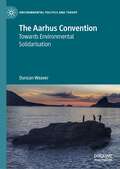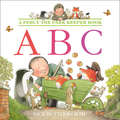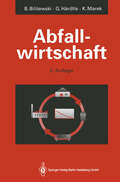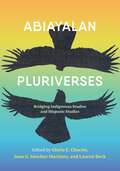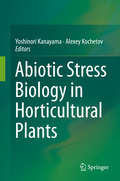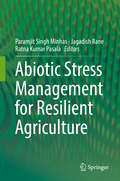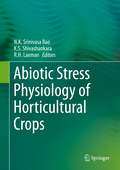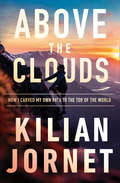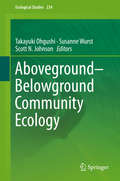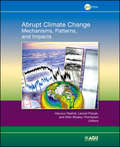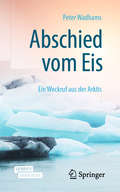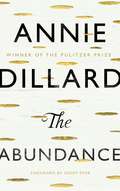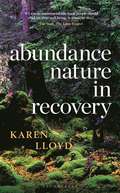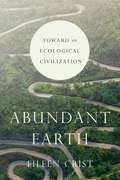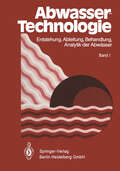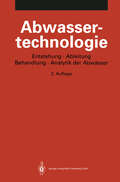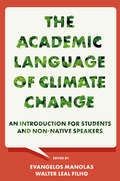- Table View
- List View
The Aarhus Convention: Towards Environmental Solidarisation (Environmental Politics and Theory)
by Duncan WeaverThe Aarhus Convention on access to information, public participation in decision-making and access to justice in environmental matters has been celebrated as a pioneering international environmental agreement. Given that a quarter-century has passed since Aarhus was opened for signature, now is an opportune moment to revisit it from a fresh perspective. Marking this anniversary, this book explores Aarhus from the vista of the English School of International Relations, an ethically-minded perspective used to gauge the prevalence of state-oriented and human-oriented progress from the Convention's rationales and realities. It firstly considers Aarhus' propagation, investigating the legal, diplomatic and geopolitical contexts enabling its emergence. It secondly investigates Aarhus' germination, with reference to its trinity of procedural rights. Thirdly, the book examines the Convention's growth, in terms of the development of its organisational infrastructure. The chief finding is that Aarhus demonstrates, in environmental contexts, the feasibility and benefit of fostering 'humankind' solidarist progress, rooted in moral cosmopolitanism, within the existing power arrangements of a sovereignty-based pluralism. Pluralist concerns for diversity and international order are found to be a precondition for more ethically ambitious solidarist endeavours. These observations reinforce the logic of solidarisation, an English School innovation that presents sovereignty as (a) being ethically matured by solidarism whilst (b) delimiting solidarism within the threshold of states' tolerance.
ABC (Percy the Park Keeper)
by Nick ButterworthLearn to the letters of the alphabet with Percy the park keeper and his animal friends in this fun first concept book from highly regarded, award-winning author/illustrator Nick Butterworth.
Abfallwirtschaft: Eine Einführung
by Bernd Bilitewski Georg Härdtle Klaus MarekDas vollständige deutschsprachige Werk zum Thema Abfall, das alle Fragen der Umweltbeauftragten auf kommunaler Ebene beantwortet. Gleichzeitig eignet sich das Buch hervorragend als Lehrbuch für Fachhochschulen und Universitäten. In der zweiten Auflage wurden auch abgesicherte Erfahrungen aus den neuen Bundesländern ausgewertet. Vor allem die Diskussion um das Duale System wird mit diesem Werk auf eine solide Basis gestellt.
Abiayalan Pluriverses: Bridging Indigenous Studies and Hispanic Studies
by Gloria ChacónAbiayalan Pluriverses: Bridging Indigenous Studies and Hispanic Studies looks for pathways that better connect two often siloed disciplines. This edited collection brings together different disciplinary experiences and perspectives to this objective, weaving together researchers, artists, instructors, and authors who have found ways of bridging Indigenous and Hispanic studies through trans-Indigenous reading methods, intercultural dialogues, and reflections on translation and epistemology. Each chapter brings rich context that bears on some aspect of the Indigenous Americas and its crossroads with Hispanic studies, from Canada to Chile. Such a hemispheric and interdisciplinary approach offers innovative and significant means of challenging the coloniality of Hispanic studies.
Abiotic Stress Biology in Horticultural Plants
by Yoshinori Kanayama Alexey KochetovThe purpose of this publication is to elucidate the biological aspect of the abiotic stress response from the field to the molecular level in horticultural plants. This book is unique in that it concerns the basic aspect of abiotic stress biology and research progress at the molecular level in model plants or major field crops, as it focuses mainly on the abiotic stress response in existing horticultural plants. Many readers interested in plant abiotic stress biology are aware of the application of the latest findings to agricultural production, and this book will have a special appeal for those readers. The book will be of interest to scientists and graduate students who are involved in the research, development, production, processing, and marketing of horticultural products, including those in developing countries who are interested in high tech and advanced science in this field. The application of the latest findings to agricultural production is particularly useful.Stress tolerance mechanisms in horticultural crops are gaining importance, because most agricultural regions are predicted to experience considerably more extreme environmental fluctuations due to global climate change. Further, because of recent progress in next-generation sequencing technologies, the postgenomic era is impending not only in model plants and major cereal crops but also in horticultural crops, which comprise a great diversity of species. This book provides information on the physiological aspects of the abiotic stress response in horticultural plants, which is considered essential for postgenomic research.
Abiotic Stress Management for Resilient Agriculture
by Paramjit Singh Minhas Jagadish Rane Ratna Kumar PasalaThis book offers a state-of-the-art overview of on abiotic stresses in terms of the challenges; scope and opportunities; copping strategies for adaptation and mitigation using novel tools for building resilience in agricultural crops and livestock; as well as for policy implementation. Divided into four major parts: advances and prospects for understanding stress environments; adaptation and mitigation options; crop-based mitigation strategies; and mitigation options in animal husbandry, the book focuses on problem-solving approaches and techniques that are essential for the medium to long-term sustainability of agricultural production systems The synthesis and integration of knowledge and experiences of specialists from different disciplines offers new perspectives in the versatile field of abiotic stress management, and as such is useful for various stakeholders, including agricultural students, scientists, environmentalists, policymakers, and social scientists.
Abiotic Stress Physiology of Horticultural Crops
by N.K. Srinivasa Rao K. S. Shivashankara R. H. LaxmanThis book brings together recent advances in the area of abiotic stress tolerance in various vegetables, fruit crops, plantation crops and tuber crops. The main challenges to improving the productivity of horticultural crops are the different types of abiotic stresses generally caused by climate change at the regional and global level. Heat, drought, cold and salinity are the major abiotic stresses that adversely affect growth and productivity and can trigger a series of morphological, physiological, biochemical and molecular changes in various horticultural crops. To date, there are no books covering horticultural crop-specific abiotic stress tolerance mechanisms and their management. Addressing that gap, the book is divided into 2 sections, the first of which highlights recent advances in the general aspects of abiotic stress tolerance like the role of hormones, reactive oxygen species, seed treatments, molecular mechanisms of heat tolerance and heavy metal toxicity, while the second focuses on the abiotic stress tolerance mechanisms of various vegetables, fruit crops, plantation crops and tuber crops. It includes comprehensive discussions of fruit crops like mango, grapes, banana, litchi and arid zone fruits; vegetables crops like tomato, capsicum, onion and tuber crops; and plantation crops like coconut, areca nut, oil palm and black pepper. Among the strategies for plant stress survival, examples of both avoidance and tolerance relevant to particular crops are examined in detail, supported by selected comprehensive case studies of progress. As such, the book offers a valuable resource suited for scientists and graduate students working in the fields of crop improvement, genetic engineering, and the abiotic stress tolerance of horticultural crops.
Above the Clouds: The Nature Of Mountains, The Terrain Of An Athlete And How I Carved My Own Path To The Top Of The World
by Kilian JornetThe most accomplished mountain runner of all time contemplates his record-breaking climb of Mount Everest in this profound and free-flowing memoir—an intellectual and spiritual journey that moves from the earth’s highest peak to the soul’s deepest reaches.
Aboveground–Belowground Community Ecology (Ecological Studies #234)
by Takayuki Ohgushi Susanne Wurst Scott N. JohnsonResearchers now recognize that above- and belowground communities are indirectly linked to one another, often by plant-mediated mechanisms. To date, however, there has been no single multi-authored edited volume on the subject. This book remedies that gap, and offers state-of-the art insights into basic and applied research on aboveground-belowground interactions and their functional consequences. Drawing on a diverse pool of global expertise, the authors present diverse approaches that span a range of scales and levels of complexity.The respective chapters provide in-depth information on the current state of research, and outline future prospects in the field of aboveground-belowground community ecology. In particular, the book’s goal is to expand readers’ knowledge of the evolutionary, community and ecosystem consequences of aboveground-belowground interactions, making it essential reading for all biologists, graduate students and advanced undergraduates working in this rapidly expanding field. It touches on multiple research fields including ecology, botany, zoology, entomology, microbiology and the related applied areas of biodiversity management and conservation.
Abrupt Climate Change: Mechanisms, Patterns, and Impacts (Geophysical Monograph Series #193)
by Harunur Rashid Leonid Polyak Ellen Mosley-ThompsonPublished by the American Geophysical Union as part of the Geophysical Monograph Series, Volume 193.Abrupt Climate Change: Mechanisms, Patterns, and Impacts brings together a diverse group of paleoproxy records such as ice cores, marine sediments, terrestrial (lakes and speleothems) archives, and coupled ocean-atmosphere climate models to document recent advances in understanding the mechanisms of abrupt climate changes. Since the discovery of the Dansgaard-Oeschger events in Greenland ice cores and the subsequent discovery of their contemporary events in the marine sediments of the North Atlantic, the search for these abrupt, millennial-scale events across the globe has intensified, and as a result, the number of paleoclimatic records chronicling such events has increased. The volume highlights include discussions of records of past climate variability, meridional overturning circulation, land-ocean-atmosphere interactions, feedbacks in the climate system, and global temperature anomalies. Abrupt Climate Change will be of interest to students, researchers, academics, and policy makers who are concerned about abrupt climate change and its potential impact on society.
Abrupt Climate Change: Mechanisms, Patterns, and Impacts (Geophysical Monograph Series #193)
by Harunur Rashid Leonid Polyak Ellen Mosley-ThompsonPublished by the American Geophysical Union as part of the Geophysical Monograph Series, Volume 193.Abrupt Climate Change: Mechanisms, Patterns, and Impacts brings together a diverse group of paleoproxy records such as ice cores, marine sediments, terrestrial (lakes and speleothems) archives, and coupled ocean-atmosphere climate models to document recent advances in understanding the mechanisms of abrupt climate changes. Since the discovery of the Dansgaard-Oeschger events in Greenland ice cores and the subsequent discovery of their contemporary events in the marine sediments of the North Atlantic, the search for these abrupt, millennial-scale events across the globe has intensified, and as a result, the number of paleoclimatic records chronicling such events has increased. The volume highlights include discussions of records of past climate variability, meridional overturning circulation, land-ocean-atmosphere interactions, feedbacks in the climate system, and global temperature anomalies. Abrupt Climate Change will be of interest to students, researchers, academics, and policy makers who are concerned about abrupt climate change and its potential impact on society.
Abschied vom Eis: Ein Weckruf aus der Arktis
by Peter WadhamsDas Meereis der Polargebiete ist nicht nur wunderschön, es reguliert auch die Temperatur der Erde. Doch es zieht sich zurück – und zwar schnell! Dabei laufen komplexe Rückkopplungen ab, die das Potenzial haben, den Klimawandel zu beschleunigen und zu verstärken. Der britische Polarforscher Peter Wadhams ist einer der international führenden Meereisexperten. Er greift auf seine fast lebenslange Forschung in der Arktis zurück, um zu erklären, was gerade passiert, was das für unsere Zukunft bedeutet – und was wir tun können und müssen.Der AutorPeter Wadhams ist einer der weltweit erfahrensten Polar- und Meereisforscher. Er war von 1987–92 Direktor des Scott Polar Institute in Cambridge und dort auch von 1992–2015 Professor für Physik der Ozeane. Er war an mehr als 50 Expeditionen in beide Polarregionen beteiligt – in Forschungscamps, auf Eisbrechern, von Flugzeugen aus, und sogar in Unterseebooten. Er wurde ausgezeichnet mit dem W. S. Bruce-Preis der Royal Society of Edinburgh (1977), der UK Polar Medal (1987) und dem Italgas-Preis für Umweltwissenschaften (1990). Er ist Fellow der Royal Geographical Society und Mitglied der Finnischen Akademie.
The Abundance: Narrative Essays Old And New (Canons #56)
by Annie DillardAnnie Dillard has spent a lifetime examining the world around her with eyes wide open, drinking in all things intensely and relentlessly. Whether observing a sublime lunar eclipse or a moth consumed in a candle flame, the trembling of lily pads on a pond or hundreds of red-winged blackbirds taking flight, Dillard's awe at the fragility of the natural world rejuvenates and inspires pleasure and heartache. Precise in language and deeply meditative in spirit, this is a landmark collection from one of America's masters.
Abundance: Nature in Recovery
by Karen LloydIn this collection of literary essays, Karen Lloyd explores abundance and loss in the natural world, relating compelling stories of restoration, renewal and repair, describing how those working on the front lines of conservation are challenging the inevitability of biodiversity loss, as well as navigating her own explorations of the meaning of abundance in the Anthropocene. In an era of urgent ecological challenge, her timely book reveals the places that people are coming together to bring species and habitats back from the edge of extinction. Yet, elsewhere, many other species are being allowed to disappear forever. To understand why, she examines how humans have chosen to entangle themselves in nature and considers the ways we perceive the natural world. A book about ways of seeing, as Lloyd explores attitudes towards meaningful restoration, she weaves her insightful and joyous narrative through a diverse range of inspiring landscapes, from Romania's Carpathian mountains and the Hungarian Steppe to Perthshire's rivers and the dune forests of the Netherlands.
Abundance: Nature in Recovery
by Karen LloydIn this collection of literary essays, Karen Lloyd explores abundance and loss in the natural world, relating compelling stories of restoration, renewal and repair, describing how those working on the front lines of conservation are challenging the inevitability of biodiversity loss, as well as navigating her own explorations of the meaning of abundance in the Anthropocene. In an era of urgent ecological challenge, her timely book reveals the places that people are coming together to bring species and habitats back from the edge of extinction. Yet, elsewhere, many other species are being allowed to disappear forever. To understand why, she examines how humans have chosen to entangle themselves in nature and considers the ways we perceive the natural world. A book about ways of seeing, as Lloyd explores attitudes towards meaningful restoration, she weaves her insightful and joyous narrative through a diverse range of inspiring landscapes, from Romania's Carpathian mountains and the Hungarian Steppe to Perthshire's rivers and the dune forests of the Netherlands.
Abundant Earth: Toward an Ecological Civilization
by Eileen CristIn Abundant Earth, Eileen Crist not only documents the rising tide of biodiversity loss, but also lays out the drivers of this wholesale destruction and how we can push past them. Looking beyond the familiar litany of causes—a large and growing human population, rising livestock numbers, expanding economies and international trade, and spreading infrastructures and incursions upon wildlands—she asks the key question: if we know human expansionism is to blame for this ecological crisis, why are we not taking the needed steps to halt our expansionism? Crist argues that to do so would require a two-pronged approach. Scaling down calls upon us to lower the global human population while working within a human-rights framework, to deindustrialize food production, and to localize economies and contract global trade. Pulling back calls upon us to free, restore, reconnect, and rewild vast terrestrial and marine ecosystems. However, the pervasive worldview of human supremacy—the conviction that humans are superior to all other life-forms and entitled to use these life-forms and their habitats—normalizes and promotes humanity’s ongoing expansion, undermining our ability to enact these linked strategies and preempt the mounting suffering and dislocation of both humans and nonhumans. Abundant Earth urges us to confront the reality that humanity will not advance by entrenching its domination over the biosphere. On the contrary, we will stagnate in the identity of nature-colonizer and decline into conflict as we vie for natural resources. Instead, we must chart another course, choosing to live in fellowship within the vibrant ecologies of our wild and domestic cohorts, and enfolding human inhabitation within the rich expanse of a biodiverse, living planet.
Abundant Earth: Toward an Ecological Civilization
by Eileen CristIn Abundant Earth, Eileen Crist not only documents the rising tide of biodiversity loss, but also lays out the drivers of this wholesale destruction and how we can push past them. Looking beyond the familiar litany of causes—a large and growing human population, rising livestock numbers, expanding economies and international trade, and spreading infrastructures and incursions upon wildlands—she asks the key question: if we know human expansionism is to blame for this ecological crisis, why are we not taking the needed steps to halt our expansionism? Crist argues that to do so would require a two-pronged approach. Scaling down calls upon us to lower the global human population while working within a human-rights framework, to deindustrialize food production, and to localize economies and contract global trade. Pulling back calls upon us to free, restore, reconnect, and rewild vast terrestrial and marine ecosystems. However, the pervasive worldview of human supremacy—the conviction that humans are superior to all other life-forms and entitled to use these life-forms and their habitats—normalizes and promotes humanity’s ongoing expansion, undermining our ability to enact these linked strategies and preempt the mounting suffering and dislocation of both humans and nonhumans. Abundant Earth urges us to confront the reality that humanity will not advance by entrenching its domination over the biosphere. On the contrary, we will stagnate in the identity of nature-colonizer and decline into conflict as we vie for natural resources. Instead, we must chart another course, choosing to live in fellowship within the vibrant ecologies of our wild and domestic cohorts, and enfolding human inhabitation within the rich expanse of a biodiverse, living planet.
Abundant Earth: Toward an Ecological Civilization
by Eileen CristIn Abundant Earth, Eileen Crist not only documents the rising tide of biodiversity loss, but also lays out the drivers of this wholesale destruction and how we can push past them. Looking beyond the familiar litany of causes—a large and growing human population, rising livestock numbers, expanding economies and international trade, and spreading infrastructures and incursions upon wildlands—she asks the key question: if we know human expansionism is to blame for this ecological crisis, why are we not taking the needed steps to halt our expansionism? Crist argues that to do so would require a two-pronged approach. Scaling down calls upon us to lower the global human population while working within a human-rights framework, to deindustrialize food production, and to localize economies and contract global trade. Pulling back calls upon us to free, restore, reconnect, and rewild vast terrestrial and marine ecosystems. However, the pervasive worldview of human supremacy—the conviction that humans are superior to all other life-forms and entitled to use these life-forms and their habitats—normalizes and promotes humanity’s ongoing expansion, undermining our ability to enact these linked strategies and preempt the mounting suffering and dislocation of both humans and nonhumans. Abundant Earth urges us to confront the reality that humanity will not advance by entrenching its domination over the biosphere. On the contrary, we will stagnate in the identity of nature-colonizer and decline into conflict as we vie for natural resources. Instead, we must chart another course, choosing to live in fellowship within the vibrant ecologies of our wild and domestic cohorts, and enfolding human inhabitation within the rich expanse of a biodiverse, living planet.
Abundant Earth: Toward an Ecological Civilization
by Eileen CristIn Abundant Earth, Eileen Crist not only documents the rising tide of biodiversity loss, but also lays out the drivers of this wholesale destruction and how we can push past them. Looking beyond the familiar litany of causes—a large and growing human population, rising livestock numbers, expanding economies and international trade, and spreading infrastructures and incursions upon wildlands—she asks the key question: if we know human expansionism is to blame for this ecological crisis, why are we not taking the needed steps to halt our expansionism? Crist argues that to do so would require a two-pronged approach. Scaling down calls upon us to lower the global human population while working within a human-rights framework, to deindustrialize food production, and to localize economies and contract global trade. Pulling back calls upon us to free, restore, reconnect, and rewild vast terrestrial and marine ecosystems. However, the pervasive worldview of human supremacy—the conviction that humans are superior to all other life-forms and entitled to use these life-forms and their habitats—normalizes and promotes humanity’s ongoing expansion, undermining our ability to enact these linked strategies and preempt the mounting suffering and dislocation of both humans and nonhumans. Abundant Earth urges us to confront the reality that humanity will not advance by entrenching its domination over the biosphere. On the contrary, we will stagnate in the identity of nature-colonizer and decline into conflict as we vie for natural resources. Instead, we must chart another course, choosing to live in fellowship within the vibrant ecologies of our wild and domestic cohorts, and enfolding human inhabitation within the rich expanse of a biodiverse, living planet.
Abundant Earth: Toward an Ecological Civilization
by Eileen CristIn Abundant Earth, Eileen Crist not only documents the rising tide of biodiversity loss, but also lays out the drivers of this wholesale destruction and how we can push past them. Looking beyond the familiar litany of causes—a large and growing human population, rising livestock numbers, expanding economies and international trade, and spreading infrastructures and incursions upon wildlands—she asks the key question: if we know human expansionism is to blame for this ecological crisis, why are we not taking the needed steps to halt our expansionism? Crist argues that to do so would require a two-pronged approach. Scaling down calls upon us to lower the global human population while working within a human-rights framework, to deindustrialize food production, and to localize economies and contract global trade. Pulling back calls upon us to free, restore, reconnect, and rewild vast terrestrial and marine ecosystems. However, the pervasive worldview of human supremacy—the conviction that humans are superior to all other life-forms and entitled to use these life-forms and their habitats—normalizes and promotes humanity’s ongoing expansion, undermining our ability to enact these linked strategies and preempt the mounting suffering and dislocation of both humans and nonhumans. Abundant Earth urges us to confront the reality that humanity will not advance by entrenching its domination over the biosphere. On the contrary, we will stagnate in the identity of nature-colonizer and decline into conflict as we vie for natural resources. Instead, we must chart another course, choosing to live in fellowship within the vibrant ecologies of our wild and domestic cohorts, and enfolding human inhabitation within the rich expanse of a biodiverse, living planet.
Abundant Earth: Toward an Ecological Civilization
by Eileen CristIn Abundant Earth, Eileen Crist not only documents the rising tide of biodiversity loss, but also lays out the drivers of this wholesale destruction and how we can push past them. Looking beyond the familiar litany of causes—a large and growing human population, rising livestock numbers, expanding economies and international trade, and spreading infrastructures and incursions upon wildlands—she asks the key question: if we know human expansionism is to blame for this ecological crisis, why are we not taking the needed steps to halt our expansionism? Crist argues that to do so would require a two-pronged approach. Scaling down calls upon us to lower the global human population while working within a human-rights framework, to deindustrialize food production, and to localize economies and contract global trade. Pulling back calls upon us to free, restore, reconnect, and rewild vast terrestrial and marine ecosystems. However, the pervasive worldview of human supremacy—the conviction that humans are superior to all other life-forms and entitled to use these life-forms and their habitats—normalizes and promotes humanity’s ongoing expansion, undermining our ability to enact these linked strategies and preempt the mounting suffering and dislocation of both humans and nonhumans. Abundant Earth urges us to confront the reality that humanity will not advance by entrenching its domination over the biosphere. On the contrary, we will stagnate in the identity of nature-colonizer and decline into conflict as we vie for natural resources. Instead, we must chart another course, choosing to live in fellowship within the vibrant ecologies of our wild and domestic cohorts, and enfolding human inhabitation within the rich expanse of a biodiverse, living planet.
Abundant Earth: Toward an Ecological Civilization
by Eileen CristIn Abundant Earth, Eileen Crist not only documents the rising tide of biodiversity loss, but also lays out the drivers of this wholesale destruction and how we can push past them. Looking beyond the familiar litany of causes—a large and growing human population, rising livestock numbers, expanding economies and international trade, and spreading infrastructures and incursions upon wildlands—she asks the key question: if we know human expansionism is to blame for this ecological crisis, why are we not taking the needed steps to halt our expansionism? Crist argues that to do so would require a two-pronged approach. Scaling down calls upon us to lower the global human population while working within a human-rights framework, to deindustrialize food production, and to localize economies and contract global trade. Pulling back calls upon us to free, restore, reconnect, and rewild vast terrestrial and marine ecosystems. However, the pervasive worldview of human supremacy—the conviction that humans are superior to all other life-forms and entitled to use these life-forms and their habitats—normalizes and promotes humanity’s ongoing expansion, undermining our ability to enact these linked strategies and preempt the mounting suffering and dislocation of both humans and nonhumans. Abundant Earth urges us to confront the reality that humanity will not advance by entrenching its domination over the biosphere. On the contrary, we will stagnate in the identity of nature-colonizer and decline into conflict as we vie for natural resources. Instead, we must chart another course, choosing to live in fellowship within the vibrant ecologies of our wild and domestic cohorts, and enfolding human inhabitation within the rich expanse of a biodiverse, living planet.
Abwassertechnologie: Entstehung, Ableitung, Behandlung, Analytik der Abwässer
by W. Czysz A. Denne H. Rump W. Schneider E. Staudte W. Supperl E. Blitz B. Böhnke P. Doetsch P. Dreschmann K. Pöppinghaus K. Siekmann S. ThomasDieses Handbuch deckt die gesamte Problematik der Abwassertechnologie ab: Abwasseranfall aus dem häuslichen und industriellen Bereich, direkte und indirekte Abwasserableitung, Abwasserbehandlung sowie der Gewässerschutz werden gemeinsam behandelt. Die umfassende Darstellung berücksichtigt nicht nur die Aspekte der Industrieländer, sondern vor allem die Probleme der Schwellen- und Entwicklungsländer. Die Auswahl der Information ist stark praxisorientiert. Das Buch liefert damit die Voraussetzung für eine fachlich abgestimmte Entwicklungspolitik auf dem Gebiet der Abwasserentsorgung und bietet Beratern, Ingenieurbüros und beteiligten Firmen eine Basis für die Diskussion, Planung und Realisierung konkreter Projekte. Es ist beabsichtigt, das Buch später auch in französischer und englischer Sprache zu publizieren.
Abwassertechnologie: Entstehung, Ableitung, Behandlung, Analytik der Abwässer
by K. Pöppinghaus W. Filla S. Sensen W. SchneiderDie Abwasserentsorgung stellt nach wie vor eine der größten Aufgaben des Umweltschutzes dar. Das Handbuch deckt den gesamten Bereich der Abwassertechnologie ab: - Abwasseranfallmengen und Konzentrationen aus häuslichen und industriellen Abwässern - Vermeidung, Verminderung und Verwertung von Abwässern - direkte und indirekte Abwasserableitung - Vorbehandlung und zentrale Behandlung der Abwässer sowie Aspekte des Gewässerschutzes.Die Neuauflage wurde hinsichtlich der neuen Philosophie der Abwasserentsorgung überarbeitet und bietet einen umfassenden Einstieg in die neuheitliche Abwassertechnologie.
The Academic Language of Climate Change: An Introduction for Students and Non-native Speakers
by Evangelos Manolas, Walter Leal FilhoClimate change is one of the greatest challenges of our time. For the sake of human civilization and life on earth we must do all we can to keep global warming at the lowest possible level. Addressing climate change is everyone’s duty and that includes teachers of English. In order to support students and non-native English speakers, this important work provides an introduction to climate change via simple chapters addressing different and important dimensions of climate change and helps students acquire basic language skills which will allow them to study similar or more difficult texts. Each chapter offers an introduction on the topic discussed and its relation to climate change, outlines climate change or other related environmental science terms and 6-8 exercises on grammar, syntax and consolidation of terminology. Topics covered include climate change and tourism, gender, worker safety, mental and physical health, food production, deforestation, art, and much more. Offering an interdisciplinary introduction to climate change and its intersection with numerous industries and facets of life, The Academic Language of Climate Change, provides a necessary and welcome introduction for undergraduate and graduate students, and any non-native English speakers seeking to engage with climate change research.
